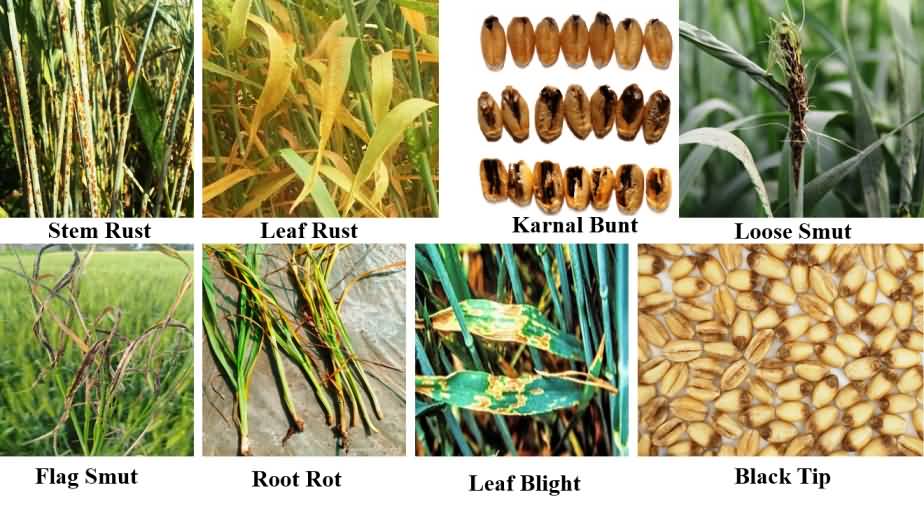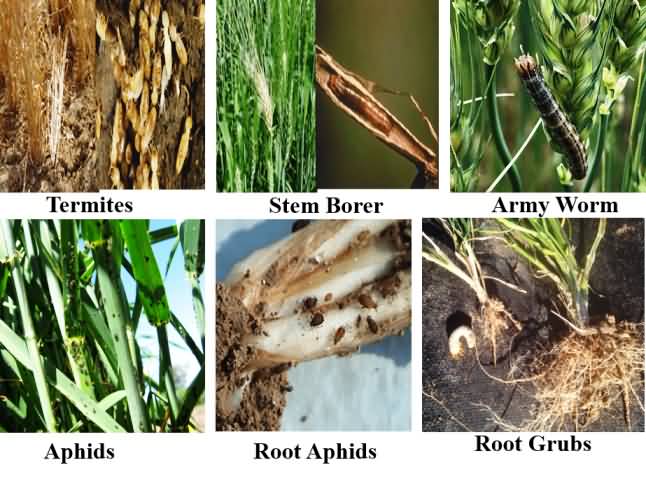मध्य भारत में उन्नत गेहूं की खेती के तरीके
Wheat is one of the most important cereal crops in India which is being cultivated in an area of 30.54 mha with a production of 106.41 mt in 2021-22. Wheat is being cultivated in 5 different zones in India viz., Northern Hilly Zone (NHZ), North Western Plains Zone (NWPZ, North Eastern Plains Zone (NEPZ), Central Zone (CZ), and Peninsular Zone (PZ).
The Central Zone consists of Madhya Pradesh, Gujarat, Chhattisgarh, Kota, and Udaipur divisions of Rajasthan and the Jhansi division of Uttar Pradesh. Among Central Zone states, Madhya Pradesh is the major producer of wheat with a production of 22.4 mt and an area of 6.5 mha.
Both species of wheat viz., durum and bread wheat are being cultivated in Madhya Pradesh. Bread wheat is used for making chapattis, bread, and biscuits. Durum wheat is used in making daliya, pasta, and semolina.
Wheat production and productivity in Central India are affected by many biotic (stem and leaf rusts, termites, lepidopteran pests, etc.) and abiotic factors (drought, heat, etc.).
Wheat production can be improved by adopting new high-yielding, disease-resistant wheat varieties, and improved production practices. Varieties are to be chosen based on the time of sowing and irrigation water availability (Table 1).
Table 1: Wheat varieties recommended for Central Zone and their recommended package of practices
|
Sowing condition |
No. of Irrigation |
Varieties |
|
|
|
|
Bread Wheat |
Durum Wheat |
|
Timely sown, restricted irrigation (20 October to 10 November) |
1-2 |
HI 1500 (Amrita), HI 1531 (Harshita), HD 2987 (Pusa Bahar), HI 1605 (Pusa Ujala), HI 1655 (Pusa Harsha), DBW 110, MP 3288, |
HI 8627 (Malavkirti), HI 8777 (Pusa Wheat 8777), HI 8823 (Pusa Prabhat), HI 8830 (Pusa Kirti), DDW 47 |
|
Timely sown irrigated (10-25 November) |
3-5 |
HI 1544 (Purna), HI 1636 (Pusa Vakula), HI 1650 (Pusa Ojaswi), GW 513 |
HI 8663 (Poshan), HI 8713 (Pusa Mangal), HI 8737 (Pusa Anmol), HI 8759 (Pusa Tejas), HI 8826 (Pusa Poshtik), HD 4728 |
|
Late sown irrigated (1 December to 5 January) |
4-5 |
HI 1633 (Pusa Vani), HI 1634 (Pusa Ahilya), MP 3336, Raj 4238, CG 1029 |
- |
Field preparation
Generally, pre-sowing irrigation is given before ploughing which allows weeds to germinate followed by ploughing. In this method, weeds can be controlled as they germinate and are controlled by ploughing but this method requires extra irrigation water as well as may delay sowing time. Therefore to save irrigation water dry sowing is recommended in which land is tilled utilizing residual moisture.
A deep ploughing followed by 2-3 harrowing by disc harrow and one or two planking is to be given to pulverize the soil and prepare the field. Deep ploughing may be avoided to conserve water if water availability is limited. This dry sowing method ensures timely sowing as well as uniform germination when irrigation is provided just after sowing.
Seed rate and Sowing
Generally, for timely sown conditions, 100 kg/ha seed is recommended for bread wheat and 125 kg/ha for durum wheat. As a thumb rule, the weight of 1000 seeds in grams is the seed rate in kg for one acre of land. The seed rate should be increased by 25% of the recommended rate for late sown conditions.
Seed should be treated with carboxin 1.25 g/kg for control of seed-borne diseases, fipronil @ 6g/kg, or chlorpyriphos @ 8ml/kg seed to control insects.
Sowing of seed and fertilizer should be either separate or fertilizer should be sown 2-3 cm deeper than seed using a seed cum fertilizer drill. The recommended spacing is 20 cm between rows.
Fertilizer requirement
The soil fertility status of the wheat fields should be known through soil testing. NPK fertilizers are to be given in the ratio of 4:2:1. Farm yard manure @ 10 tonnes/ha is to be given along with inorganic fertilizers.
The cultivation of green manuring crops (Sunnhemp or dhaincha) and their incorporation into the soil improves soil health, fertility, and water-holding capacity.
Table 2 : Fertilizer requirement of wheat under different sowing conditions
|
Condition |
N:P:K (kg/ha) |
Required straight Fertilizers in kg |
|
Restricted irrigation |
80 : 40: 20 |
Urea: 180, Super phosphate: 250 Muriate of Potash :30 |
|
Timely sown irrigated
|
Bread wheat : 120 : 60 : 30 |
Urea: 260, Super phosphate: 375 Muriate of Potash :50 |
|
Durum :140 :70: 35 |
Urea: 300 Super phosphate: 440 Muriate of Potash :60 |
|
|
Late sown |
100 :50: 25 |
Urea: 220 Super phosphate: 310 Muriate of Potash :42 |
Irrigation water requirement
Black soil (Black Cotton Soil) is the major soil type in Central Zone. The soil is rich in calcium carbonate, potash, lime, and magnesium carbonate but has poor phosphorus content. It has a high water holding capacity.
The variety should be chosen depending on the number of irrigation water available to farmers. In Madhya Pradesh, long beds of wheat are prepared for irrigation purposes. However, these are not good for saving water and require more water. Therefore 20 x 20 meters square beds should be prepared by horizontal and vertical channels around the field using a plough/ridger.
This method will minimize the loss of water and there would be proper control of water. If sufficient irrigation water is available then irrigation is to be given at an interval of 20-25 days. If one irrigation water is available, then it should be given at 35-45 DAS, if two are available then one should be given at 35-40 DAS, and the second at 70-80 DAS.
Similarly, if three are available then irrigation water can be applied at 20-25 DAS, 50-55 DAS, and 80- 85 DAS. However, in the case of red soils, lighter irrigation should be given more frequently as their water holding capacity is less and water loss due to infiltration is more.
Weed control measures
Weeds can be managed either through mechanical or chemical methods. A bullock-drawn hand hoe or wheel hoe can be used for weed control at 15-20 DAS and 35-40 DAS. This practice controls weed population and improves aeration and earthing up.
Manual weeding along wheat rows can be done using a hand-held sickle. However, manual weeding requires a lot of labour, and in places with a shortage of labours, weedicides can be used to manage the weeds.
|
Pre-emergence herbicide |
Pendimethalin @ 1.0 kg/ha |
|
Post-emergence weedicides (Sprayed at 30-45 DAS) |
|
|
2,4-D @ 0.60 to 0.75 kg/ha or Metsulfuron methyl @4 gm/ha or Halauxifen methyl @ 12.76 g/ha |
|
Clodinafop propergyl @ 60 gm/ha or Sulfosulfuron @ 25 g/ha |
|
Clodinafop propargyl + Metsulfuron methyl or Sulfosulfuron + Metsulfuron methyl or Mesosulfuron + Iodosulfuron (14.4 g/ha) Metribuzin 250 g /ha |
Diseases and pests in wheat and their management
The major diseases affecting wheat cultivation in the central zone are stem rust, leaf rust, leaf blight, Karnal bunt, loose smut, black point, and flag smut. Symptoms of different diseases include :
- Stem rust : dark brown coloured pustules appear on leaves, stems, ear heads, glumes awns
- Leaf rust - orange-brown colored pustules on leaves
- Leaf blight - brown-coloured necrotic areas on leaves leading to dried leaves
- Karnal bunt- a few grains of an ear are filled with blackish powder which has a fishy odour
- Loose smut - the entire ear head is converted into a black powdery mass
- Flag smut - long, black raised streaks on the leaves, leaf sheaths, awns, and sometimes on the stems breaks open to reveal the mass of powdery grey-black spores and stunted plants
- Black tip - discoloured grain tip which becomes black
 Fig.1. Different diseases affecting wheat crop
Fig.1. Different diseases affecting wheat crop
Integrated disease management measures:
- Discouraging old varieties and growing new improved wheat varieties
- Varieties recommended for other zones of India should not be grown
- Growing durum wheat along with bread wheat will check the epidemic of rust diseases due to their differences in resistance spectrum
- Use of healthy certified seeds for sowing
- Application of balanced fertilizers
- Avoid sprinkler irrigation after ear head emergence
- Seed treatment with carboxin 2g/kg seed for control root rot, karnal bunt, loose smut and flag smut
- Propiconazole @ 1ml/ltr for the control of foliar diseases like rusts and blights
The major pests affecting wheat production in the central zone are termites, aphids, root aphids, armyworms, stem borers, white grubs, and rats.
 Fig.2. Insect pests affecting wheat crop
Fig.2. Insect pests affecting wheat crop
Integrated pest management
- For termites management, seed treatment with Fipronil 5% FS 6 ml or Chlorpyriphos 20% EC 4.5 ml per kg seed is to be done and in the standing crop, broadcasting 100 kg sand mixed with 1.5 liter Fipronil 5 % SC or Chlorpyriphos 20% EC and followed by light irrigation
- Spraying Imidacloprid 300ml/ha for the control of sucking insects like aphids and root aphids
- For white grubs, setting up of light traps @ 1/ha, seed treatment and spraying imidacloprid should be followed
- Spraying chlorantraniliprole 18.5 SC @ 200g/ha or Emamectin benzoate 5SG @ 250g/ha or flubendiamide 480SC @ 20g/ha for controlling larvae of cutworm, armyworm etc
- For rat control in the wheat field, 3-gram Zinc phosphide mixed with 100 grams of wheat or gram flour and little groundnut oil & jaggery and made into balls are to be placed in rat holes or tablets of Aluminium phosphide or celphos can be placed and the same closed airtight by wet farm yard manure and soil.
Wheat harvesting and Storage
Once the wheat crop attains maturity, the crop can be harvested manually and tied in bundles and threshed. Combine harvesters can also be utilized to harvest and thresh the crop. If harvesting is delayed, then the shattering of grains may occur. The ideal grain moisture for storage should be around 12 percent. Wheat grain can be stored in jute bags, metal containers, grain bins, etc.
Authors:
Prakasha T L
ICAR-IARI Regional Station, Indore-452 001
Email:
